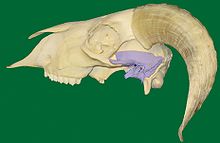Temporal bone
The temporal bone ( Latin os temporale ) is one of the bones of the brain skull . It lies laterally in the back of the skull. The temporal bone contains the middle and inner ear and forms the joint socket of the temporomandibular joint .
The temporal bone is divided into four parts:
- Pars squamosa (scale part)
- Pars tympanica (part of the tympanic membrane, surrounds the ear canal and the middle ear)
- Pars mastoidea (wart part)
- Pars petrosa (rock part, temporal bone )
While the temporal bone scale (pars squamosa) is connected to the neighboring cranial bones by sutures ( suturae ), the remaining parts of the temporal bone are wedged between the temporal bone scale , occiput , sphenoid and parietal bone and fastened by connective tissue (so-called gomphosis ). This is why these parts are also known collectively as the petrous pyramid in animals , but only the actual pars petrosa in humans .
Pars squamosa
The pars squamosa (scale part or temporal bone scale), phylogenetically derived from the scale bone (squamosum), is the largest section of the temporal bone and forms part of the lateral wall of the cranial cavity .
In the anterior area is the zygomatic process ( processus zygomaticus ossis temporalis ), which forms the zygomatic arch ( arcus zygomaticus ) with the processus temporalis of the zygomatic bone . In the direction of the occiput, the zygomatic arch continues as a shallow ridge ( crista supramastoidea ) over the entire temporal bone scale .
At the base of the yoke process is the articular surface for the (secondary) jaw joint in mammals, which is known as the mandibular fossa . The retroarticular process rises behind it .
Pars tympanica
The pars tympanica (part of the tympanic membrane ) surrounds the external auditory canal ( porus acousticus externus ) and, together with the eardrum, forms the lateral (lateral) wall of the tympanic cavity ( cavum tympani ) and thus the middle ear .
In some mammals (humans, horses , cattle ) the tympanic part forms a bony cuff around the styloid process (stylus extension) of the tympanic part ( vagina processus styloidei ). Between the tympanic part and the pars petrosa there is a fissure , the fissura petrotympanica . The chorda tympani (drum string) of the facial nerve pulls through it outwards.
Pars mastoidea
The mastoid part (wart part) carries the mastoid process ( processus mastoideus ). It is used to insert some long neck muscles ( sternocleidomastoid muscle ). The mastoid process is hollow in most mammals. The cavity inside the mastoid process ( antrum mastoideum ) is lined by a mucous membrane like the middle ear and is connected to the tympanic cavity via an opening ( aditus ad antrum ). In connection with the antrum, there are further cavities, the mastoid cells ( Cellulae mastoideae ) , to a very variable extent . The antrum and cellules contain air that communicates with the nasopharynx via the middle ear and the ear trumpet .
Pars petrosa
The petrous bone or the petrosal pyramid ( pars petrosa [ossis temporalis], petrosum , outdated also pyramis ) is the hardest bone of the mammalian and human skull and a section of the temporal bone ( os temporale ).
See also
literature
- Franz-Viktor Salomon: Bony skeleton . In: Franz-Viktor Salomon u. a. (Ed.): Anatomy for veterinary medicine . Enke, Stuttgart 2004, ISBN 3-8304-1007-7 , pp. 37-110 .
Web links
Individual evidence
- ↑ Federative Committee on Anatomical Terminology (FCAT) (1998). Terminologia Anatomica . Stuttgart: Thieme.


